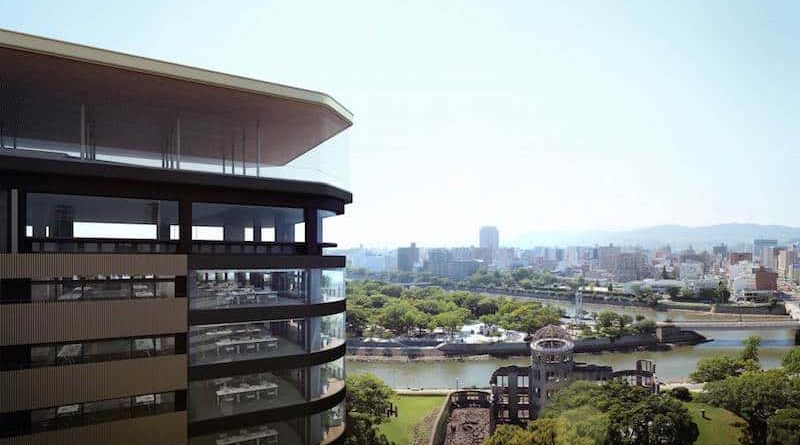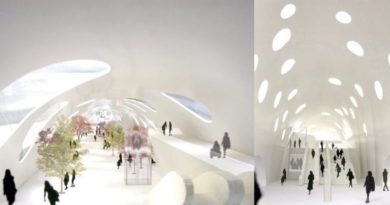Hiroshima Orizuru Tower
Hiroshima’s post-war city leaders always envisioned that tourism would play a key role in the recovery of the A-bombed city of Hiroshima, indeed, it was a key factor in securing special funding from Tokyo for reconstruction. There has, however, always been a tension between the idea of the Hiroshima Peace Memorial Park as a sacred space and the forces of commercialization. Just last year, the relocation of the Kanawa oyster restaurant up the Motoyasu River caused some consternation and raised concerns above overdevelopment of the area around the park. [日本語]
Today, a repurposed 13-story building, owned by car dealer Hiroshima Mazda Co., opens right on the border between the sacred space and Hiroshima’s bustling commercial center. Most of the Orizuru Tower, which overlooks the iconic A-bomb Dome, will be taken up by office space, but, its owners also have a firm eye on the burgeoning tourist market and hope it will be a strong draw for visitors.

The building’s main attraction is a stylish observation deck on the top floor which offers an amazing view. You can look almost directly down upon the A-bomb Dome, over the Peace Memorial Park, out to the Inland Sea and Miyajima to the southwest, and can see Hiroshima Castle to the north. On the 12th floor are interactive installations on the theme of the orizuru origami cranes that, via the story of Sadako Sasaki, have become a symbol of Hiroshima. At street level is a well-designed gift store and a modern cafe with indoor and outdoor seating.
While some might be tempted to dismiss the development as that of a big company jumping on the inbound tourism bandwagon, it is worth looking at Hiroshima Mazda’s “Hiroshima credentials”. Hiroshima Mazda Co., is independent of the Mazda Motor Corporation and was founded in 1933 by Shuya Matsuda, son of Mazda Corporation founder Jujiro Matsuda, when it sold the fledgling auto-maker’s 3-wheeled trucks in what was then called Sarugaku-cho (now Kamiya-cho). On incorporation in 1941, the company moved a little west to the corner directly behind the Hiroshima Prefectural Industrial Promotion Hall (now the A-bomb Dome). While his father escaped the devastation of the A-bombing, only meters from the bomb’s hypocenter, Shuya Matsuda, his company headquarters and all his staff were wiped out by the blast. While, after a short stint in Niho, the company moved to Noboricho in 1949, for many years plot next to the A-bomb Dome was occupied by a rather non-descript office building.
As a company that predates the bombing and that has benefited from, as well as contributed to, the recovery of the city, Hiroshima Mazda says it feels an obligation to honor the past, repay the support of the local population and look to the future. It does make for good PR copy, but one would have to be extremely cynical to deny that when it came time to redevelop the building, the company felt a sense of responsibility to create a space worthy of a location that people from all over the world come to visit. Hiroshima Mazda thus aimed to create a place that would be open to the public, used to promote the city’s message of peace while continuing to engage in the world of commerce.
Interestingly, while buildings are continually being torn down and rebuilt all over Hiroshima and up and down Japan, Hiroshima Mazda decided to refurbish their existing building. The exterior of the old building was removed, but the original frame has been preserved and given a new, more substantial, exterior, highly resistant to potential earthquakes.
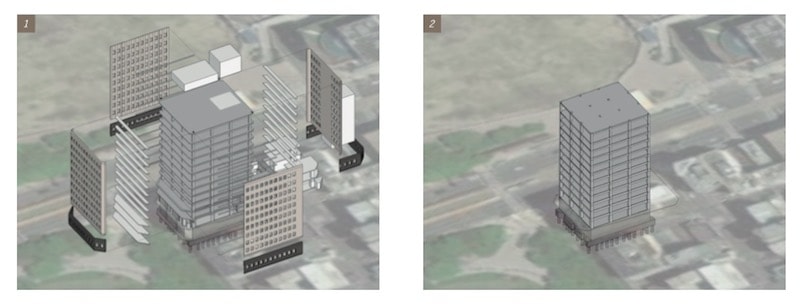
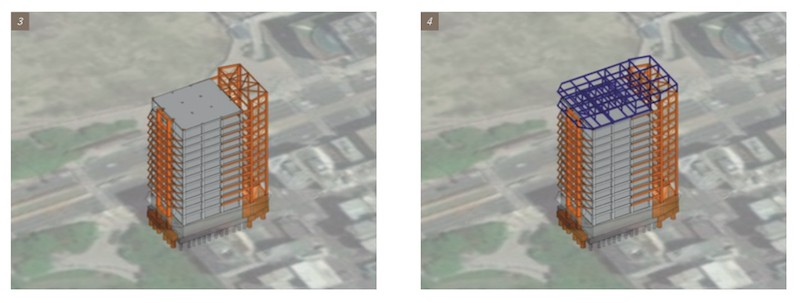
The new exterior serves to do more than provide structural support and give the building a distinctive look; it also provides a buffer against direct sunlight, reducing the cost of cooling the office floors. Recessed windows, earth tones and greenery on the side facing the A-bomb Dome are all designed to harmonize with the surrounding and to lessen visual impact on the part of people viewing the A-bomb Dome from ground level.
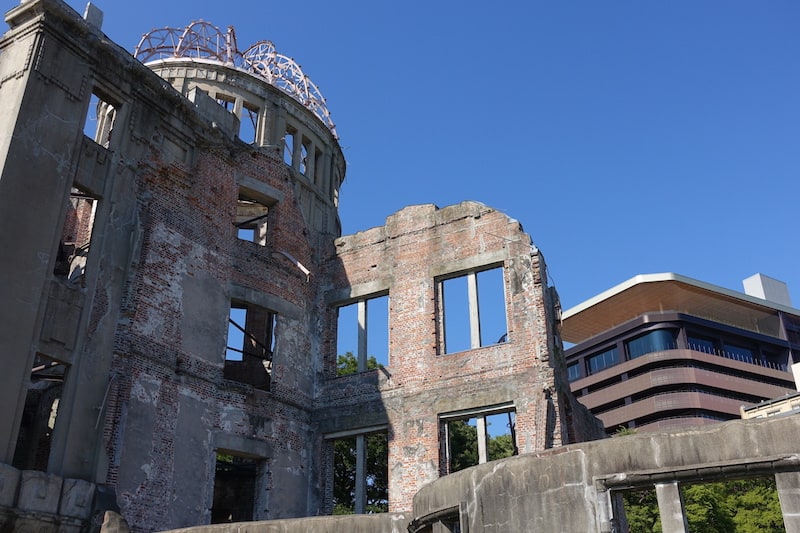
Using the original building frame is estimated to have saved some 67% of the amount of carbon emissions that a total rebuild would have created. The job of designing all this was given to Hiroshima-based architect Hiroshi Sambuichi, who is also responsible for the viewing platform on top of Mt Misen on Miyajima and Otafuku’s ‘Wood Egg’ building. In trademark Sambuichi style, natural airflow is utilized throughout the building, reducing carbon emissions due to cooling by 33%.
Enough about the background and the concept, is the Orizuru Tower worth visiting?
I have been highly critical of many of the city’s recent architectural developments, and I was fully prepared to hate this one too. To my surprise, however, the Orizuru Tower has quite charmed me. Entering the building, one is greeted by a surprising number of staff, dressed in smart uniforms and the lobby has the feel of an expensive hotel. The gift shop, which is stocked mostly with local food products, is very well designed and the English labels are pretty good too.

To get to the main attraction, the observation deck, you have to purchase a ticket. Now here is the kicker; admission is ¥1700 for adults (scroll down for all prices). Buy a ticket from a machine (English directions provided) and make your way through the turnstiles, from where you can choose to take the elevator up to the 13th floor or walk up the semi-open side of the building. I recommend taking the elevator up and walking down, but if you are looking to boost your step count (and your heart rate), go for it; the walk up has both steps and a continuous slope all the way to the top.
Should you opt for the elevator, you will experience a highly polished, old school Japanese elevator lady welcome – a slow, deep bow and a very polite Japanese greeting and explanation of what the elevator is about to do, all delivered at perfect elevator lady pitch.
On exiting the elevator, you pass a cafe which sells drinks and light snacks and walk up a few steps to the entrance to the observation deck. The deck is lovely, inspired by Ise-jingu Shrine, which Prime Minister Shinzo Abe was so keen to show off to the leaders of the G7, it has a low ceiling supported by wooden pillars and smooth wooden floor which slopes down towards a balcony from where you can look right down on the A-bomb Dome and over the Peace Memorial Park.

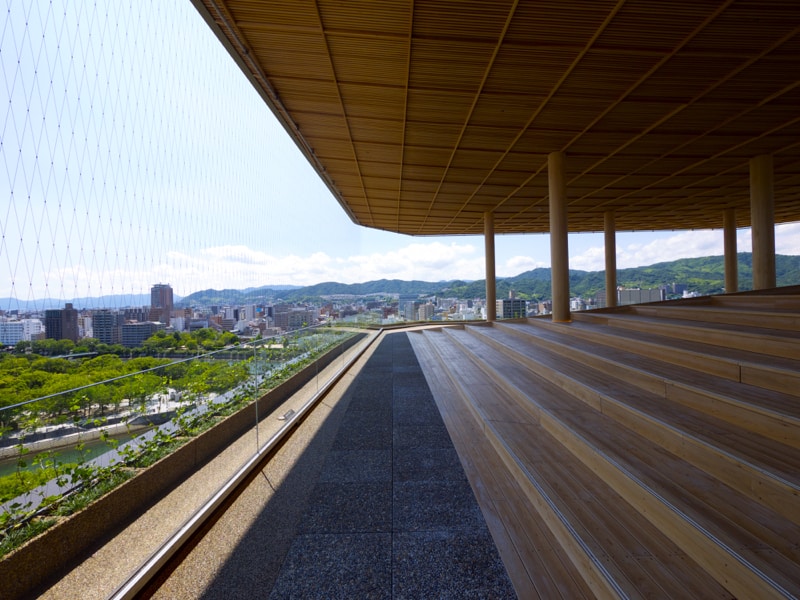
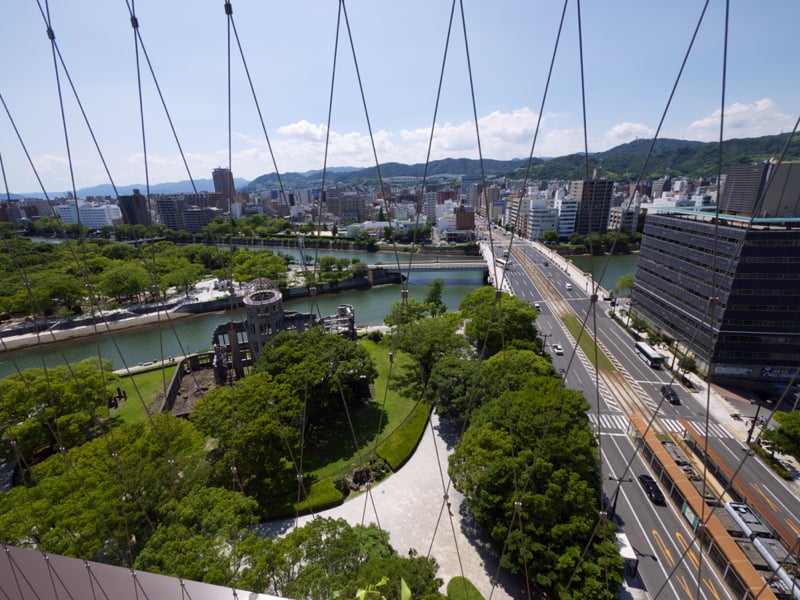
You can also see Hiroshima Castle to the north and the island of Miyajima to the southwest. Open to the elements, when I visited on a beautiful clear summer day, the breeze was delightfully refreshing and it brought to mind the Senjokaku ‘1000 Mat Pavillion’ on Miyajima. I’m not sure if it is part of the design or purely to prevent birds from inadvertently flying in (or depressed visitors taking the fast way down), but there is a wide mesh barrier, which makes it impossible to get totally unobstructed views and photos to the view (keep reading for a way around that).
See more photos of the Orizuru Tower observation deck
It would be quite easy to while away quite some time on the deck, especially as visitors are welcome to take drinks and food from the cafe out with them. I imagine that, when the weather is fine, this will be a wonderful place to watch the sun set over the mountains.
One floor below is an interactive space, called the ‘workshop zone’, which is also open to the public. Here, you can fold your own orizuru origami peace cranes (there are instructions in English and friendly helpers are on hand to assist).
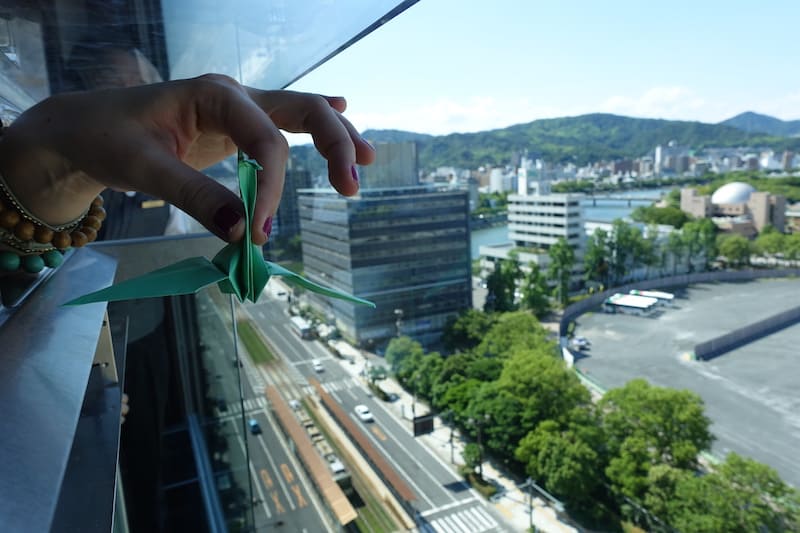
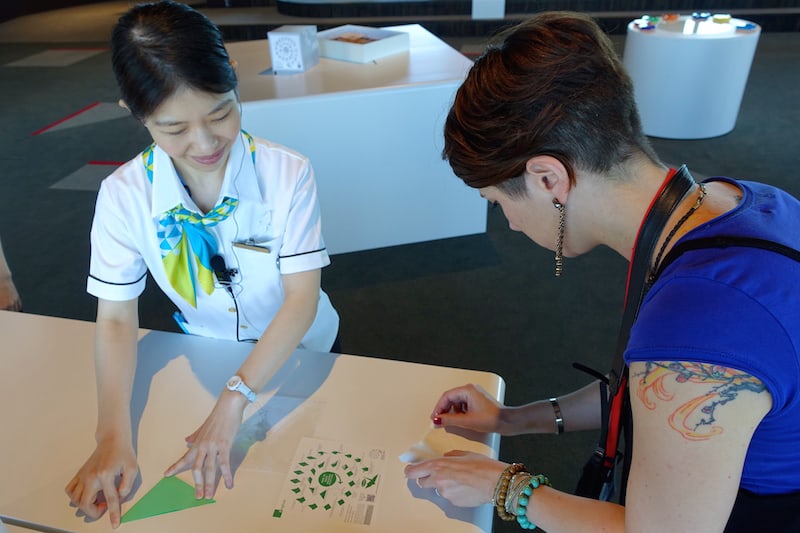
You’ll also find a couple of digital installations using orizuru motifs, including ‘Air Orizuru’, a kind of big screen Wii-style origami game.
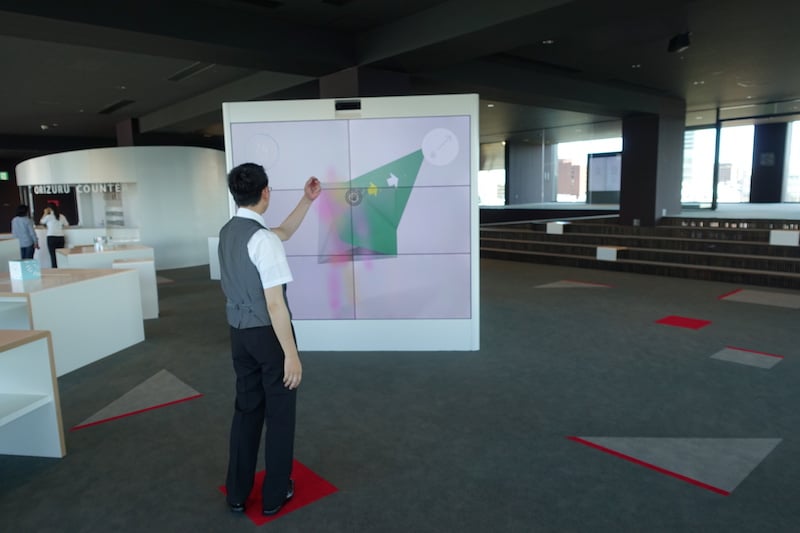
A panoramic CGI video display shows the redevelopment of Hiroshima from to a burnt plain in 1945 to the city of today. This floor also offers fantastic views through the plate glass windows, unobstructed by mesh. In one corner, a platform indicates the location of the Shima Hospital, above which the A-bomb exploded, which can been seen from the window.
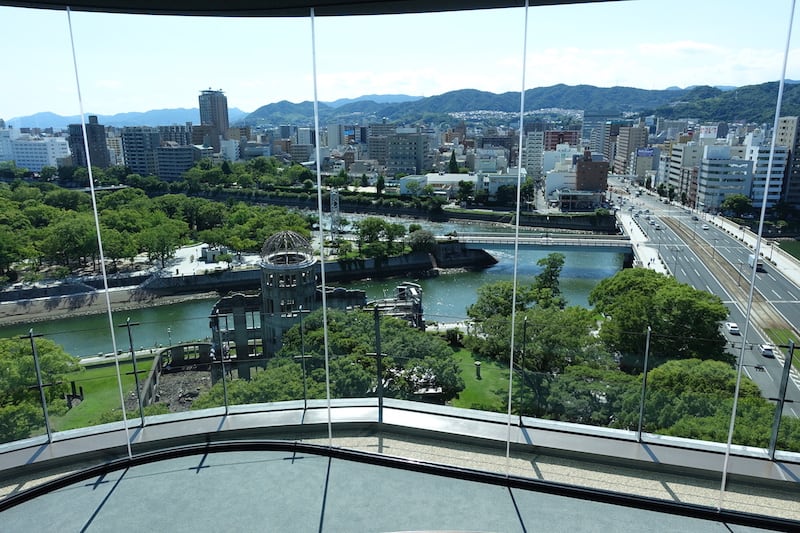
One major feature of the building’s design, not yet mentioned, is a 50m tall chimney-like glass ‘crane wall’ on one side of the building. Visitors can pay an extra fee, for which they will receive specially designed origami paper with which to fold their crane and be able to squeeze into the top of the chimney and toss their creation into the dropspace the wall. Apparently, it will take half a million or so origami cranes to fill the wall, which will be viewable from outside, creating a kind of orizuru monument.

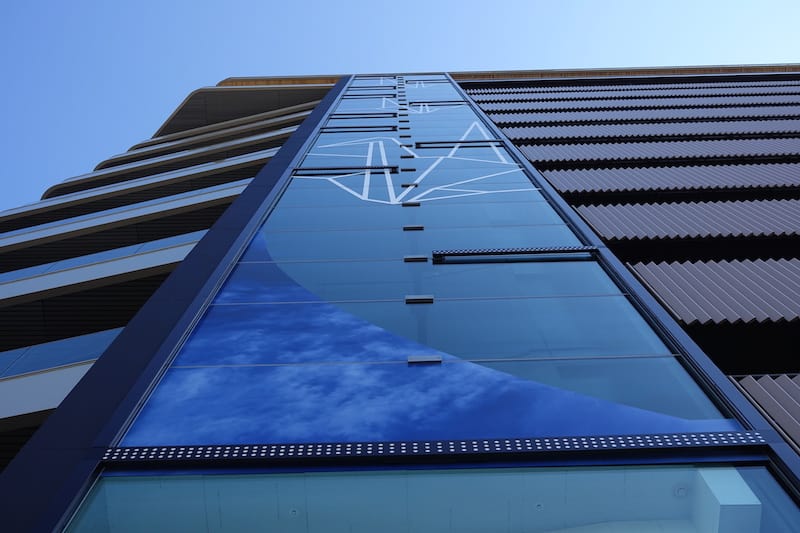
Those who a not great with heights be warned, to ’throw-in’ your crane you have to stand on a plexiglass ledge that allows you to see all the way down to the street.
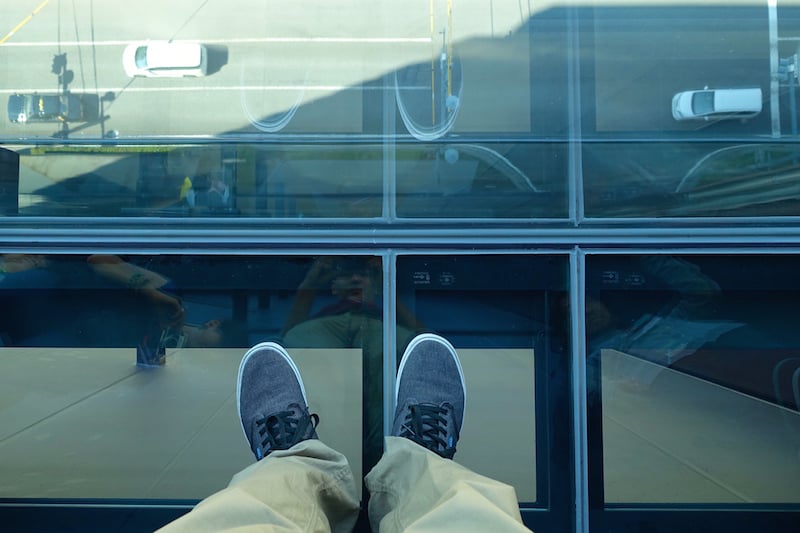
Should you choose to not to pay the surcharge, you will receive some perfectly acceptable paper and you can choose to take your crane away with you or place it in a specially designed receptacle. I initially imagined that these cranes would be deployed somewhere for a time, but staff informed me that they are to be recycled to produce more origami paper for future visitors.
After you take in the observation deck and the interactive floor, the Orizuru Tower has one more thing to give; the descent. The walk down the sloped walkway that winds its way down the side of the building is also open and offers some views, though you are mostly looking out across the air conditioning units on top of the uninspiring buildings (although I must confess, as a long term resident, I quite enjoyed that). There will, we are told, also be works by manga artist Shuho Sato on exclusive display on the walls. More fun, however, is to jump on the emergency exit slides that run between each floor. You have to keep changing slides at every floor, as obviously it’s important not to build up too much speed when fleeing a fire.
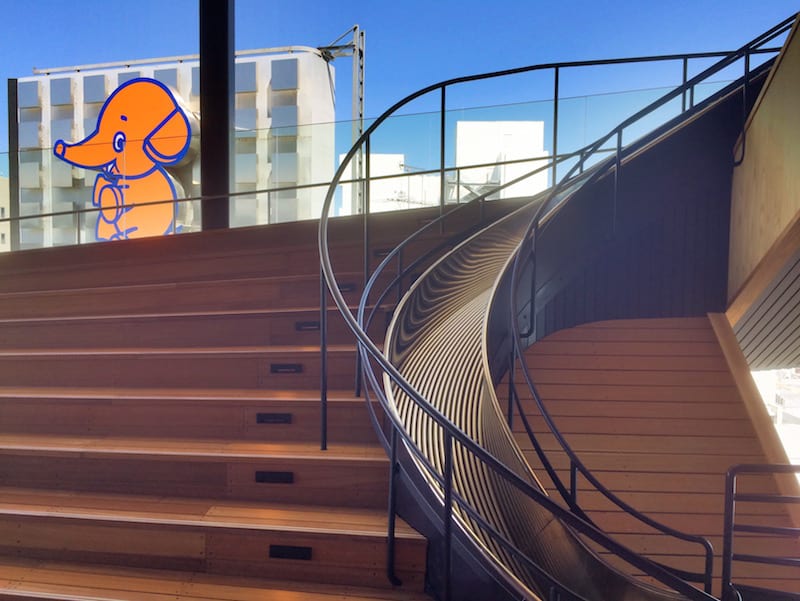
As I mentioned above, I was pleasantly surprised by the Orizuru Tower and I only have a couple of qualms.
First, the reimagining of the orizuru origami cranes as a kind of entertainment didn’t sit quite right with me. It can, however, certainly be argued that the orizuru and the story of Sadako Sasaki provide a way to broach the subject of the horror which nuclear weapons can unleash to children who may find exhibits at the Peace Memorial Museum too disturbing. Personally, I would prefer my origami cranes to be collected with those of other visitors and hung up at one of the memorials in the Peace Memorial Park or elsewhere, at least for a short time.
The other is, well, it’s a little pricey. Although it’s a bargain compared to the Skytree, it’s more expensive than going 250m up Tokyo Tower. I have no doubt that it will prove to be very popular with domestic tourists, but I do wonder how many overseas tourists will be happy to pay such a high entrance fee for a view from the 13 floor, only 50m above ground. Also, to charge an extra ¥500 (¥600 if you don’t buy your extra “orizuru throw in” ticket in the lobby and choose to pay once you get to the 12th floor) seems a little excessive. Time will tell.
Admission
- 18 years and over ¥1700
- 12-17 years ¥900
- 6-11 years ¥700
- 4-5 years ¥500
I was lucky to get a look around the building free of charge. I found some things a little gimmicky; the orizuru-themed installations, the see-through platform at the top of the Orizuru Wall and the somewhat random manga displays. All that said, I would definitely be prepared to make another visit; on a clear day, around sunset with a bottle of wine and someone special to share it with.
http://www.orizurutower.jp/ (website currently available in Japanese, English and French)


